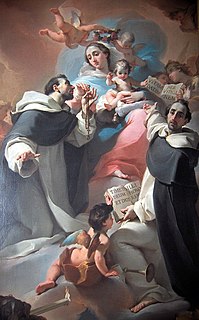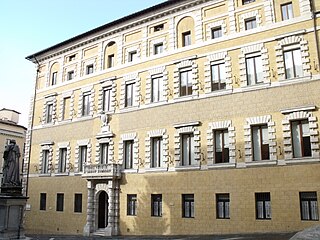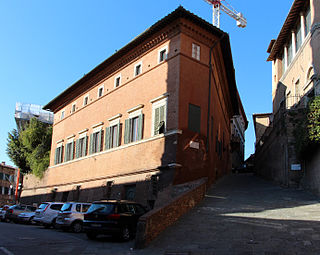
Ubaldo Gandolfi (1728–1781) was an Italian painter of the late-Baroque period, mainly active in and near Bologna.

The Palazzo Chigi-Saracini is a Gothic urban palace on the Via di Città in the Terzo di Città in central Siena, Tuscany, Italy. In 2014 it housed the Accademia Musicale Chigiana.

Palazzo Salimbeni is a Gothic style urban palace located on the Piazza Salimbeni, just off Via Banchi di Sopra in the Terzo di Camollia of the city of Siena, region of Tuscany, Italy. The building, associated with an ancient mercantile family of Siena, currently houses the main offices of the Banca Monte dei Paschi di Siena, one of the oldest banks in the world.
The following is a timeline of the history of the city of Siena, Tuscany, Italy.

Piazza d'Aracoeli is a square of Rome (Italy), placed at the base of the Capitoline Hill, in the Rione X Campitelli.

The Palazzo Tolomei is an imposing, Gothic style urban palace, located on Via Banchi di Sopra in the present contrada of Civetta, Terzo di Camollia of the city of Siena, region of Tuscany, Italy.

The Palazzo Bichi Ruspoli, or previously Palazzo or Castellare dei Rossi, is an urban palace, located on Via Banchi di Sopra in the present contrada of Civetta, Terzo di Camollia of the city of Siena, region of Tuscany, Italy.

The Palazzo Spannocchi is a Renaissance style urban palace located on the Piazza Salimbeni, just off Via Banchi di Sopra in the Terzo di Camollia of the city of Siena, region of Tuscany, Italy. The building was associated with an ancient mercantile family of Siena.

The Palazzo Piccolomini, also known as the Palazzo Todeschini Piccolomini is a Renaissance-style palace in the city of Siena, region of Tuscany, Italy. It is located on the Banchi di Sotto, at the corner with Via Rinaldini; uphill and west of the church of San Martino, the Loggia del Papa, and the Palazzo delle Papesse, which also built by a Piccolomini family member.

The Palazzo Tantucci is a Renaissance style urban palace localized on Via dei Montanini, on the Piazza Salimbeni, in the Terzo di Camollia, in the city of Siena, region of Tuscany, Italy. To the palace's right is the Gothic facade of the Palazzo Salimbeni, and across the Piazza with Sallustio Bandini's statue is the Classic Renaissance facade of the Palazzo Spannocchi. All three palaces are owned now by the Monte dei Paschi di Siena, one of the oldest banks in Europe, which arose in the Salimbeni palace.

The Palazzo Marsili Libelli is a Gothic style urban palace localized on Via di Città #136-142, in the Terzo di Città, in the city of Siena, region of Tuscany, Italy. The palace is adjacent to the taller Palazzo Marsili with a crenellated roofline and mullioned second and third story windows, and which stands at the corner of Via di Città and Via del Castoro.

San Niccolò al Carmine, also called Santa Maria del Carmine is a Renaissance style, Roman Catholic church and monastery located in Pian dei Mantellini #30, near the corner of Via della Diana in the Terzo de Citta of Siena, region of Tuscany, Italy. The church now serves as the Oratory for the Contrada of Pantera. Across the street from the belltower is the Palazzo Celsi Pollini. North along Pian dei Mantellini, toward the Arco delle Due Porte, and on the same side of the street are a number of palaces built around what was once the Monastery of the Derelict Women: in order they are the Neoclassical Palazzo Incontri, the Palazzo Ravissa and the Palazzo Segardi.

Palazzo Sansedoni is a Gothic style urban palace and tower, whose concave facade is situated facing the Palazzo Pubblico across the Piazza del Campo in the political center of the city of Siena, region of Tuscany, Italy.

The Palazzo Chigi all Postierla, but sometimes referred also to as Chigi-Piccolomini or Piccolomini-Adami is a Renaissance style urban palace localized on Via del Capitano #1, corner Piazza Postierla, in the Terzo di Città, in the city of Siena, region of Tuscany, Italy. The palace is up the street from the Palazzo del Capitano del Popolo, Siena.

The Palazzo del Capitano del Popolo is a 13th-century Gothic style, brick and stone, urban palace located on via del Capitano, #13-19 in the city of Siena, region of Tuscany, Italy. The name derives because it was once home of the Capitano della Guerra or Capitano del Popolo, who served as the main official for the Republic. The Palazzo is just off the Piazza of the Duomo.

The Palazzo Celsi Pollini, once also called the Palazzo del Vescovo, is a Renaissance style urban palace in Siena, Italy. It is located on Pian dei Mantellini #39-41, at the corner with Via San Quirico. A 19th-century source refers to the house as Casa Campioni. The main facade faces the campanile of San Niccolò del Carmine.
The Palazzo Incontri is a Neoclassical style urban palace locate on Pian dei Mantellini in Terzo di Citta of Siena, region of Tuscany, Italy. The palace rises between the church and convent of San Niccolò al Carmine and what was formerly the Convento delle Derelitti. Across the street is the Palazzo Celsi Pollini, Siena.

The Palazzo Bandini-Piccolomini is a Renaissance style urban palace located on via Sallustio Bandini #32, corner Via San Vigilio in the city of Siena, region of Tuscany. It is across the street from the rear facade of the Castellare degli Ugurghieri. The palace was constructed circa 1460, and the design has been attributed to Cecco di Giorgio. The priest and proto-economist Sallustio Bandini was born in the house. The facade is mainly brick. The portal and window mouldings are made of grey pietra serena and has a Piccolomini shield with 5 crescent moons. The portal also has images of children astride dolphins. The second story windows have triangular pediments. The small interior courtyard has a well. The iron rings on the facade were formerly used to tie up horses. The property is owned by the University of Siena.

The Palazzo Piccolomini-Clementini is a Gothic-style palace located on Via Banchi di Sotto #75 in the city of Siena, region of Tuscany, Italy. It is located across the street from the more imposing Renaissance-style Palazzo Piccolomini and the Loggia del Papa. The nearby Palazzo delle Papesse was also built by a Piccolomini family member.
The Palazzo Fani Mignanelli is a Gothic-style building, located on via Banchi di Sopra in the city of Siena, region of Tuscany, Italy.






















